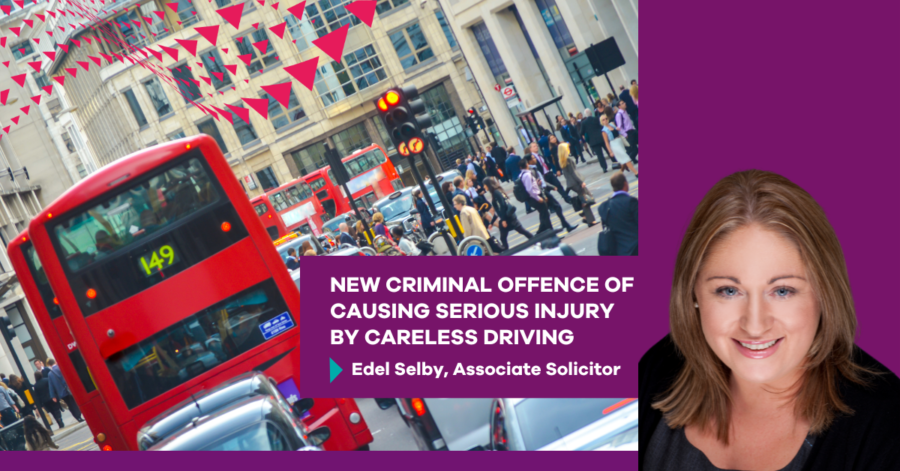New criminal offence of Causing Serious Injury by Careless Driving


New criminal offence of ‘causing serious injury by careless driving’ – giving greater acknowledgment to those seriously injured on our roads
Until recently there was no official offence of ‘causing serious injury by careless driving’; therefore, when a careless driver caused serious injury, they could only be prosecuted for the offence of ‘careless driving’. However, the law has just got significantly tougher for inattentive drivers whose actions result in serious injury to others.
On 28 June 2022 a new offence of ‘Causing Serious Injury by Careless Driving’ came into UK law, under The Police Crime and Sentencing Act 2022.
In 2017, the Government published the response to its consultation where one of the questions asked was in relation to a perceived gap in the law, and whether there was a need to create a new offence in relation to causing serious injury, beyond the two existing offences of Causing Serious Injury by Dangerous Driving and Causing Serious Injury when Driving Disqualified. This was met with overwhelming strong support, with approximately 90% of respondents being in favour of the creation of a new offence, Causing Serious Injury by Careless or Inconsiderate Driving.
One of the key considerations raised in response to the consultation was that cases of serious and often permanent injury can have devastating impacts on the victims. This is something we are all too aware of at Minster Law. Without the introduction of this new offence, drivers who did not meet the high standards of Dangerous Driving offences could only be prosecuted for the offence of Driving Without Due Care and Attention (otherwise known as Careless Driving). A key argument for the introduction of new legislation was that a charge of Careless Driving only relates to the manner of the driving and does not reflect the seriousness of any injury caused.
Prior to this, one would often see serious injury cases where the offence of ‘careless driving’ did not feel like a significant enough charge but the offending motorist actions did not meet the threshold to bring a dangerous driving charge. The injured party and their families often felt that the charge of careless was not a reflection of the life changing injuries that had been suffered as a result.
The offence of ‘Careless Driving’ carries a maximum sentence of a fine, together with a driving licence endorsement of three to nine penalty points, or in the most serious cases in terms of both culpability and harm, the court can use its discretion to impose a driving disqualification.
The new law aims to close a loophole in the difference between punishing ‘careless’ versus ‘dangerous’ driving. The new Act places greater emphasis on the extent of the injury rather than the extent of the carelessness and attaches harsher penalties the more significant the injury.
Careless driving is deemed as that which falls below the required standard of a ‘competent and careful driver’ (section 3ZA of the Road Traffic Act 1988). Examples of this include displaying a lack of concentration or avoidable distraction. Dangerous driving (section 2A) refers to driving which falls far below the expected standard. This could include being distracted whilst using a handheld mobile phone at the wheel.
The new offence is an either-way offence, which means that it can be heard in the magistrates’ court (known as a ‘summary offence’) or Crown Court (known as ‘on indictment’). The defendant can choose which court hears their case – in the magistrates’ court it will be heard and decided by a panel of magistrates or a District Judge, whereas in the Crown Court it will be decided by a jury. If convicted in the Crown Court, the driver can face a maximum sentence of two years imprisonment. If convicted in the Magistrates’ Court, the driver can face a one-year sentence. In both cases, the convicted driver will also face an obligatory disqualification.
To be convicted of this new offence, the prosecution needs to prove that the driver’s level of driving fell below the required standard, which could be as little as a momentary lapse in concentration. So, for the same error of judgment, a driver convicted of the new offence will now not only lose their licence but is also at risk of being sent to prison.
Previously, an individual convicted of causing serious injury through careless driving would face a summary only offence; that is, disqualification and an unlimited fine. This new law allows for increased penalties with judges able to hand down lengthy custodial sentences as well as extended driving bans for the most extreme cases where ‘really serious bodily harm’ has occurred.
Recent amendments to the Highway Code created a hierarchy of road users and placed a responsibility on those who can cause the greatest harm to reduce the danger that they pose to others. As a result, we may reasonably expect to see an increase in prosecutions under this new offence, especially where the injured party is a vulnerable road user, such as pedestrians and cyclists.
It will be some time before the effects of this new offence are clear. The possibility of a custodial sentence means drivers now face more severe consequences if convicted for Causing Serious Injury by Careless Driving, rather than just Careless Driving, and it may result in an increasing number seeking to deny the charges. For those also bringing civil claims for the serious injury they have suffered it may mean they have to wait longer for liability to be determined, where they are, to some degree, dependant on the conclusion of the criminal case. Nonetheless, the introduction of Causing Serious Injury by Careless Driving is likely to offer victims far greater recognition of the significant and often permanent injury they have suffered, and ensure that those found to have been responsible for such injuries are handed more severe penalties.